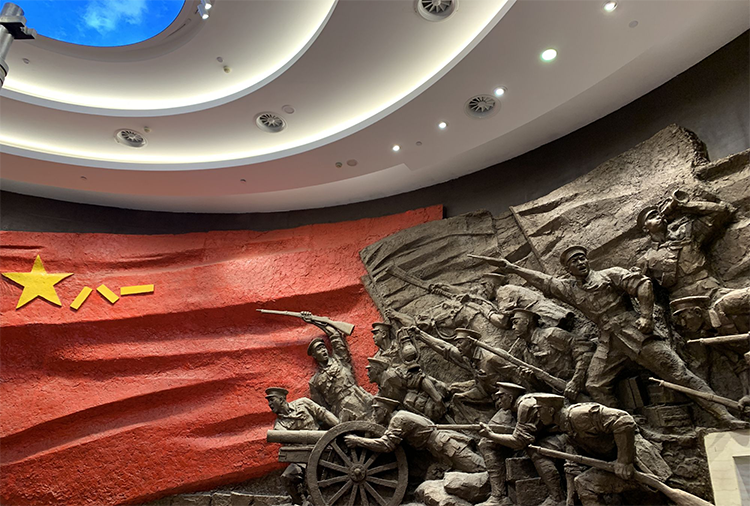Nanchang August 1 Uprising Museum: Discover Chinese Military History at the Birthplace of China’s Army
Introduction
Push open the vermilion gates of the Nanchang August 1 Uprising Museum and you are transported back to a stormy summer night in 1927. Housed in the former Jiangxi Grand Hotel, this gray-brick building was the command center for the first shots of a revolution. Today it is a national first-class museum that uses artifacts and spatial storytelling to bring history alive: rusted rifles, yellowed battle maps and immersive projections combine to return visitors to the dawn when China’s military was born.
1. The Cradle of Military Spirit: How a Hotel Changed History
The soul of the museum lies in how the building itself and more than a thousand artifacts weave together the epic of founding a national army. As China’s only memorial dedicated to the birth of its armed forces, every brick here supports the core narrative of “the place where the military flag was raised.”
In 1927 the Jiangxi Grand Hotel was a five-story Sino-Western building: curved balconies and carved railings still reflect Republican-era style. Leaders such as Zhou Enlai and He Long planned the uprising here through the night. The second-floor meeting room remains arranged as it was—rattan chairs, oil lamps and handwritten operation plans—offering a double experience of historical site and exhibition that makes the past feel within reach.
2. Treasures of the Museum: Feel the Temperature of History
• Hanyang-made rifle used by uprising forces
The rifle marked No.5927 is a museum highlight. Wear on the stock shows it traveled with the uprising units across great distances. An interactive screen beside it simulates loading the weapon so visitors can understand how the arms were operated.
• Zhou Enlai’s handwritten revisions to the August 1 Declaration
The yellowed declaration paper bears ink corrections made with a brush—visible evidence of the revolutionary urgency. An English translation in the display case helps international visitors appreciate its historical significance.
• Immersive panorama “The Nanchang Uprising”
A 360-degree circular gallery combines large oil paintings with sound and light to recreate the uprising: midnight gunfire lights the city and the shouts of soldiers echo from all directions. This immersive experience is a top photo spot for visitors.
3. The Power of Narrative: How to Read This History
The exhibition is organized like a rigorous historical volume:
– First floor: a chronological timeline with over 200 photographs that set the social backdrop of the night before the uprising.
– Second floor: focus on the uprising itself, alternating original artifacts with scene reconstructions.
– Third floor special exhibition “From Nanchang to the Nation” uses scale models to explain the subsequent troop movements and long-range campaigns.
A noteworthy “International Perspective” section uses English-language archives to explain the roles of Soviet advisors and the Comintern, offering foreign visitors a broader context.

4. Visitor Guide: Explore Like a Historian
Basic information
– Address: No. 380 Zhongshan Road, Xihu District, Nanchang (Bayi Museum Station, Line 1, Exit 5; 3-minute walk)
– Opening hours: 09:00–17:00 (last entry 16:30). Closed Mondays.
– Admission: Free; reservation required using passport through the museum’s official WeChat account.
Recommended routes
– Quick visit (1 hour): Former command headquarters → Panorama gallery → Arms hall
– In-depth visit (3 hours): Add archives room → Military telegraph decoding interactive → Special temporary exhibitions
Local tips
– Bilingual guided tours are available daily at 10:00 and 14:30 (free).
– The backyard stele grove inscribed with commanders’ handwriting is quiet and emotionally powerful.
– The Uprising Memorial Tower, diagonally opposite the museum, is the best spot for full-building photos.
5. Extended Experiences: Time-Travel through Nanchang
Create a red-culture day trip linking the museum with nearby sites:
Morning:
Nanchang August 1 Uprising Museum → He Long Command Post
Lunch:
Taste Jiangxi flavors at Zhongshan Road’s long-established Huang Ji Clay Pot Soup
Afternoon:
Visit the former New Fourth Army headquarters → Watch the Gan River sunset from Tengwang Pavilion

Conclusion
At the Nanchang August 1 Uprising Museum history takes on striking shape. Standing on the balcony where Zhou Enlai once strategized and looking out over busy Zhongshan Road, you understand the truth behind the phrase “a single spark can start a prairie fire.” This enduring red landmark awaits you to unlock one of China’s most stirring revolutionary chapters.


